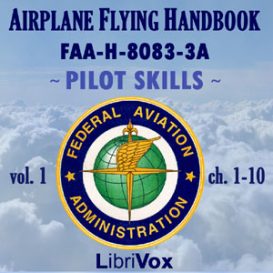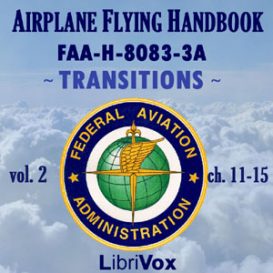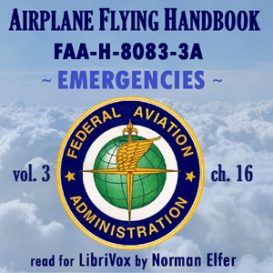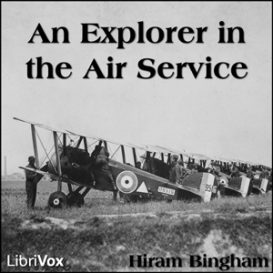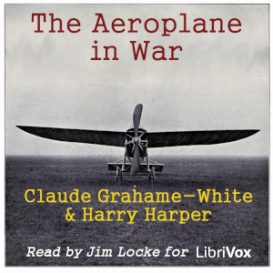Transportation
Showing all 19 results
Airplane Flying Handbook FAA-H-8083-3A – Vol. 1
This audiobook contains chapters 1 through 10 from the Airplane Flying Handbook FAA-H-8083-3A. Study of the handbook should include the PDF from the FAA, which is available at http://www.faa.gov/regulations_policies/handbooks_manuals/. From the preface: “The Airplane Flying Handbook is designed as a technical manual to introduce basic pilot skills and knowledge that are essential for piloting airplanes. It provides information on transition to other airplanes and the operation of various airplane systems. It is developed by the Flight Standards Service, Airman Testing Standards Branch, in cooperation with various aviation educators and industry. This handbook is developed to assist student pilots learning to fly airplanes. It is also beneficial to pilots who wish to improve their flying proficiency and aeronautical knowledge, those pilots preparing for additional certificates or ratings, and flight instructors engaged in the instruction of both student and certificated pilots. It introduces the future pilot to the realm of flight and provides information and guidance in the performance of procedures and maneuvers required for pilot certification.” This audiobook, chapters 1 through 10 from the Airplane Flying Handbook, is Volume I. Chapters 11 -15 titled “Transition to ….” are recorded in Volume 2, and Chapter 16 “Emergency Procedures” is recorded in Volume 3. – Summary by Norman Elfer
Airplane Flying Handbook FAA-H-8083-3A – Vol. 2
This audiobook is volume 2 from the Airplane Flying Handbook FAA-H-8083-3A. This volume covers chapters 11 to 15, on transitions to complex, multiengine, tailwheel, turboprop, and jet aircraft. Study of the handbook should include the PDF from the FAA, which is available at http://www.faa.gov/regulations_policies/handbooks_manuals/ . From the preface: “The Airplane Flying Handbook is designed as a technical manual to introduce basic pilot skills and knowledge that are essential for piloting airplanes. It provides information on transition to other airplanes and the operation of various airplane systems. It is developed by the Flight Standards Service, Airman Testing Standards Branch, in cooperation with various aviation educators and industry.” Chapters 1-10 are recorded in Volume 1 and Chapter 16, Emergency Procedures, is Volume 3. – Summary by Norman Elfer
Airplane Flying Handbook FAA-H-8083-3A – Vol. 3
This audiobook is third and final volume of the Airplane Flying Handbook. This volume is chapter 16, Emergency Procedures. From the preface: “The Airplane Flying Handbook is designed as a technical manual to introduce basic pilot skills and knowledge that are essential for piloting airplanes. It provides information on transition to other airplanes and the operation of various airplane systems. It is developed by the Flight Standards Service, Airman Testing Standards Branch, in cooperation with various aviation educators and industry.” This volume applies to basic piloting skills and training aircraft, Volume 1, as well as transitions to other types of aircraft, Volume 2. – Summary by Norman Elfer
Among Typhoons And Pirate Craft
Anderson served as third officer aboard the Eamont. Eamont was an opium clipper built in Cowes. Eamont was involved in the opening of Japan to foreigners in 1858, serving as a dispatch boat between Nagasaki and Shanghai, and was one of the first vessels to open up a trade with Formosa. The Eamont was employed in the negotiations for the first commercial treaty with Japan. On this occasion she ran into Nagasaki and quietly dropped anchor, in spite of the fact that opposition to the proposed commercial treaty was very strong at the time. On the following morning 150 boat-loads of Japanese attempted to tow her to sea, being evidently ignorant of an anchor’s raison d’etre. But though they attempted several similar methods to get rid of her they refrained from any armed attack, and, eventually, her mission was completely successful. This was in 1858, and the Eamont’s crew saw many wonderful sights in that tierra incognita. The September Typhoon of 1858 destroyed several well-known opium clippers at Double Island, including the Anonyma, Gazelle, Pantaloon, and Mazeppa. Eamont was anchored off Double Island, with “150 fathoms of chain out and a second anchor backed on it at 60 fathoms.” The waves in the anchorage were estimated to be as large as 40 feet, and the Eamont?s crew had to cut away her masts. Eamont was one of only two ships in that anchorage to survive the night, the other being the Hazard. (See Wikipedia article on Eamont (schooner)) (Wikipedia and david wales)
An Explorer in the Air Service
Explorer Hiram Bingham discovered Machu Picchu in 1911, as recounted in his book Inca Lands, now released on LibriVox at http://librivox.org/inca-lands-by-hiram-bingham/. In 1917, he became an aviator and organized the United States Schools of Military Aeronautics at eight universities to provide ground school training for aviation cadets, and then in Issoudun, France, Bingham commanded the primary Air Service flying school. He became a supporter of the Air Service in their post-war quest for independence from the Army and supported that effort, in part, with the publication of this book of his wartime experiences published in 1920 by Yale University Press. (Summary by Wikipedia and ToddHW)
The Aeroplane in War
“Although it is still a crude machine?in view of the perfected apparatus which is the aim of thoughtful designers?the aeroplane has demonstrated, in a conclusive way, its value as an instrument of war.” – Summary by Authors



